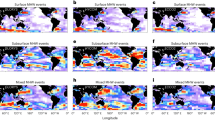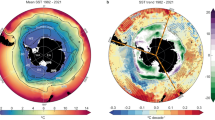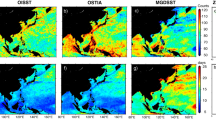Abstract
The ocean’s surface layer has a crucial role in Earth’s climate, absorbing excess atmospheric heat, thereby regulating global temperatures. Here, using global daily sea surface temperature (SST) data, we document a notable increase in the persistence of SST anomalies across the global ocean since 1982. This trend is also evident in frequency space, showing a decreased variance in SSTs on timescales shorter than a month, but a slight increase on longer timescales. A simple stochastic model attributes this prolonged memory to three key factors––a deepening of the surface mixed layer, a weakening of oceanic forcing and reduced damping rates. The first two factors decrease the variance on shorter timescales, while the third increases it on longer timescales. Our findings have great relevance to the observed increase in the duration of marine heatwaves and the associated heightened thermal threats to marine organisms. Our study also suggests that the ocean’s ability to sequester heat is weakening.
This is a preview of subscription content, access via your institution
Access options
Access Nature and 54 other Nature Portfolio journals
Get Nature+, our best-value online-access subscription
27,99 € / 30 days
cancel any time
Subscribe to this journal
Receive 12 print issues and online access
209,00 € per year
only 17,42 € per issue
Buy this article
- Purchase on SpringerLink
- Instant access to full article PDF
Prices may be subject to local taxes which are calculated during checkout




Similar content being viewed by others
Data availability
Details regarding the source database utilized in this study can be found at the following URLs: https://doi.org/10.5067/GHAAO-4BC21 (ref. 52) and https://doi.org/10.24381/cds.bd0915c6 (ref. 38). The global maps illustrating the trend and climatology MLD fields discussed in this paper are available via Zenodo at https://doi.org/10.5281/zenodo.4073174 (ref. 53).
Code availability
The analytical code employed for the results and Supplementary Information in this paper can be accessed at https://github.com/ChaehyeongLee/ThermalMemory.git (ref. 54).
References
Frankignoul, C. & Hasselmann, K. Stochastic climate models, Part II Application to sea-surface temperature anomalies and thermocline variability. Tellus A: Dyn. Meteorol. Oceanogr. 29, 289–305 (1977).
Deser, C., Alexander, M. A., Xie, S.-P. & Phillips, A. S. Sea surface temperature variability: Patterns and mechanisms. Annu. Rev. Mar. Sci. 2, 115–143 (2010).
Xie, S.-P. A dynamic ocean–atmosphere model of the tropical Atlantic decadal variability. J. Clim. 12, 64–70 (1999).
Rhein, M. & Rintoul, S. R. et al. in Climate Change 2013: The Physical Science Basis (eds Stocker, T. F. et al.) Ch. 3 (Cambridge Univ. Press, 2013).
Trenberth, K. E., Fasullo, J. T. & Balmaseda, M. A. Earth’s energy imbalance. J. Clim. 27, 3129–3144 (2014).
von Schuckmann, K. et al. Heat stored in the earth system 1960–2020: where does the energy go? Earth Syst. Sci. Data 15, 1675–1709 (2023).
Hasselmann, K. Stochastic climate models Part I. Theory. Tellus 28, 473–485 (1976).
Marshall, J. & Plumb, R. A. in Atmosphere, Ocean and Climate Dynamics: An Introductory Text (eds Dmowska, R., Hartmann, D. & Rossby, T.) 262–266 (Elsevier, 2008).
Boulton, C. A. & Lenton, T. M. Slowing down of North Pacific climate variability and its implications for abrupt ecosystem change. Proc. Natl Acad. Sci. USA 112, 11496–11501 (2015).
Patrizio, C. R. & Thompson, D. W. J. Understanding the role of ocean dynamics in midlatitude sea surface temperature variability using a simple stochastic climate model. J. Clim. 35, 3313–3333 (2022).
Frölicher, T. L. & Laufkötter, C. Emerging risks from marine heat waves. Nat. Commun. 9, 650 (2018).
Mills, K. E. et al. Fisheries management in a changing climate: lessons from the 2012 ocean heat wave in the Northwest Atlantic. Oceanography 26, 191–195 (2013).
Moore, J. A. Y. et al. Unprecedented mass bleaching and loss of coral across 12° of latitude in Western Australia in 2010–11. PLoS ONE 7, 51807 (2012).
Smale, D. A. et al. Marine heatwaves threaten global biodiversity and the provision of ecosystem services. Nat. Clim. Change 9, 306–312 (2019).
Lenton, T. M., Dakos, V., Bathiany, S. & Scheffer, M. Observed trends in the magnitude and persistence of monthly temperature variability. Sci. Rep. 7, 5940 (2017).
Ding, R. & Li, J. Decadal and seasonal dependence of North Pacific sea surface temperature persistence. J. Geophys. Res.: Atmos. 114, D01105 (2009).
Hobday, A. J. et al. A hierarchical approach to defining marine heatwaves. Prog. Oceanogr. 141, 227–238 (2016).
Hobday, A. J. et al. Categorizing and naming marine heatwaves. Oceanography 31, 162–173 (2018).
Oliver, E. C. J. et al. Marine heatwaves. Annu. Rev. Mar. Sci. 13, 313–342 (2021).
Botsford, L. W., Lawrence, C. A., Dever, E. P., Hastings, A. & Largier, J. Effects of variable winds on biological productivity on continental shelves in coastal upwelling systems. Deep-Sea Res. II: Top. Stud. Oceanogr. 53, 3116–3140 (2006).
García-Reyes, M., Largier, J. L. & Sydeman, W. J. Synoptic-scale upwelling indices and predictions of phyto- and zooplankton populations. Prog. Oceanogr. 120, 177–188 (2014).
Aguirre, C., Garreaud, R. D. & Rutllant, J. A. Surface ocean response to synoptic-scale variability in wind stress and heat fluxes off south-central Chile. Dyn. Atmos. Oceans 65, 64–85 (2014).
Aguirre, C., Rojas, M., Garreaud, R. D. & Rahn, D. A. Role of synoptic activity on projected changes in upwelling-favourable winds at the ocean’s eastern boundaries. npj Clim. Atmos. Sci. 2, 44 (2019).
Dillon, M. E. et al. Life in the frequency ___domain: the biological impacts of changes in climate variability at multiple time scales. Integr. Comp. Biol. 56, 14–30 (2016).
Bulgin, C. E., Merchant, C. J. & Ferreira, D. Tendencies, variability and persistence of sea surface temperature anomalies. Sci. Rep. 10, 7986 (2020).
Reynolds, R. W. et al. Daily high-resolution-blended analyses for sea surface temperature. J. Clim. 20, 5473–5496 (2007).
Oliver, E. C. J. et al. Longer and more frequent marine heatwaves over the past century. Nat. Commun. 9, 1324 (2018).
Sallée, J. B. et al. Summertime increases in upper-ocean stratification and mixed-layer depth. Nature 591, 592–598 (2021).
Klinger, B. A. & Haine, T. W. N. Ocean Circulation in Three Dimensions Ch. 4 (Cambridge Univ. Press, 2019).
Frankignoul, C. & Kestenare, E. The surface heat flux feedback. Part I: Estimates from observations in the Atlantic and the North Pacific. Clim. Dyn. 19, 633–648 (2002).
Hausmann, U., Czaja, A. & Marshall, J. Estimates of air–sea feedbacks on sea surface temperature anomalies in the Southern Ocean. J. Clim. 29, 439–454 (2016).
Kwiatkowski, L. et al. Twenty-first century ocean warming, acidification, deoxygenation, and upper-ocean nutrient and primary production decline from CMIP6 model projections. Biogeosciences 17, 3439–3470 (2020).
Jo, A. R. et al. Future amplification of sea surface temperature seasonality due to enhanced ocean stratification. Geophys. Res. Lett. 49, 2022–098607 (2022).
Shi, H. et al. Global decline in ocean memory over the 21st century. Sci. Adv. 8, 3468 (2022).
Li, J. & Thompson, D. W. J. Widespread changes in surface temperature persistence under climate change. Nature 599, 425–430 (2021).
Banzon, V., Smith, T. M., Chin, T. M., Liu, C. & Hankins, W. A long-term record of blended satellite and in situ sea-surface temperature for climate monitoring, modeling and environmental studies. Earth Syst. Sci. Data 8, 165–176 (2016).
Huang, B. et al. Improvements of the Daily Optimum Interpolation Sea Surface Temperature (DOISST) version 2.1. J. Clim. 34, 2923–2939 (2021).
Hersbach, H. et al. The ERA5 global reanalysis. Q. J. R. Meteorol. Soci. 146, 1999–2049 (2020).
Sen, P. K. Estimates of the regression coefficient based on Kendall’s tau. J. Am. Stat. Assoc. 63, 1379–1389 (1968).
Theil, H. in Henri Theil’s Contributions to Economics and Econometrics Vol. 23 (eds Raj, B. & Koerts, J.) 345–381 (Springer, 1992).
Mann, H. B. Nonparametric tests against trend. Econometrica 13, 245–259 (1945).
Kendall, M. G. Rank Correlation Methods (Griffin, 1948).
Gilbert, R. O. Statistical Methods for Environmental Pollution Monitoring (Wiley, 1987).
Hussain, M. & Mahmud, I. pyMannKendall: a Python package for non parametric Mann Kendall family of trend tests. J. Open Source Softw. 4, 1556 (2019).
Box, G. E. P., Jenkins, G. M. & Reinsel, G. C. Autocorrelation Function and Spectrum of Stationary Processes in Time Series Analysis : Forecasting and Control 3rd edn, 46–59 (Prentice Hall, 1994).
Bhattacharya, P. K. & Burman, P. Theory and Methods of Statistics 1st edn, 431–489 (Academic Press, 2016).
Roll, H. U. Physics of the Marine Atmosphere (Academic, 1965).
Large, W. G. & Yeager, S. G. Diurnal to Decadal Global Forcing for Ocean and Sea-Ice Models: The Data Sets and Flux Climatologies. NCAR/TN–460+STR, NCAR Technical Note (Univ. Corporation for Atmospheric Research, 2004).
Hausmann, U., Czaja, A. & Marshall, J. Mechanisms controlling the SST air–sea heat flux feedback and its dependence on spatial scale. Clim. Dyn. 48, 1297–1307 (2017).
Yang, P., Jing, Z. & Wu, L. An assessment of representation of oceanic mesoscale eddy–atmosphere interaction in the current generation of general circulation models and reanalyses. Geophys. Res. Lett. 45, 11856–11865 (2018).
Yuan, M., Li, F., Ma, X. & Yang, P. Spatio-temporal variability of surface turbulent heat flux feedback for mesoscale sea surface temperature anomaly in the global ocean. Front. Mar. Sci. 9, 957796 (2022).
NASA/JPL GHRSST Level 4 AVHRR_OI Global blended sea surface temperature analysis (GDS2) from NCEI. NASA Physical Oceanography Distributed Active Archive Center https://doi.org/10.5067/GHAAO-4BC21 (2020).
Sallée, J.-B. et al. Fifty-year changes of the world ocean’s surface layer in response to climate change. Zenodo https://doi.org/10.5281/zenodo.5776180 (2021).
Lee, C. ChaehyeongLee/ThermalMemory: V1.0.0. Zenodo https://doi.org/10.5281/zenodo.13863062 (2024).
Acknowledgements
H.S. was supported by a National Research Foundation of Korea grant funded by the Korean government (2018R1A5A1024958 and 2022R1A2C1009792). J.M. was supported by the Physical Oceanography program of the National Aeronautics and Space Administration (6945064) and the Massachusetts Institute of Technology–Goddard Institute for Space Studies cooperative agreement.
Author information
Authors and Affiliations
Contributions
H.S. designed the study. C.L. and H.S. performed the analysis. C.L. created the figures. Y.C., A.C. and J.M. helped in the investigation. C.L. wrote the original draft and C.L., H.S., Y.C. and J.M. reviewed and edited the paper.
Corresponding author
Ethics declarations
Competing interests
The authors declare no competing interests.
Peer review
Peer review information
Nature Climate Change thanks the anonymous reviewers for their contribution to the peer review of this work.
Additional information
Publisher’s note Springer Nature remains neutral with regard to jurisdictional claims in published maps and institutional affiliations.
Extended data
Extended Data Fig. 1 The mean memory timescales obtained by fitting an arctangent function.
a-e. The mean memory timescales (\(\overline{\tau }\)) of SST anomalies over a 42-year period (1982-2023). Optimal coefficients for the arctangent function are determined using 2, 5, 10, 20, and 30 consecutive autocorrelation coefficients of SST anomalies, spanning from 0-lag to the lag (n − 1).
Extended Data Fig. 2 The trend in the mean memory timescales obtained by fitting an arctangent function.
a-e. The linear trend of the memory timescale is calculated using the same arctangent model used to produce the means shown in Extended Data Fig. 1a–e. from 1982 to 2023, respectively.
Extended Data Fig. 3 Mean damping coefficients.
a-b. Mean atmospheric (λa) and mean oceanic (λo) damping coefficient over the last 42 years. The atmospheric damping coefficient is decomposed into three contributions: c. long-wave radiation (λrad), d. sensible heat flux (λsh), and e. latent heat flux (λlh). The units are in W m−2 K−1.
Extended Data Fig. 4 Power spectra of atmospheric forcing.
a-e. Power spectra of annual atmospheric forcing (\({\hat{F}}_{\omega ,a}^{2}\)) for the five regions, denoted by black boxes in Fig. 1b, are presented in every 10-year interval from 1982 to 2023.
Supplementary information
Supplementary Information
Supplementary Figs. 1–3 and Table 1.
Rights and permissions
Springer Nature or its licensor (e.g. a society or other partner) holds exclusive rights to this article under a publishing agreement with the author(s) or other rightsholder(s); author self-archiving of the accepted manuscript version of this article is solely governed by the terms of such publishing agreement and applicable law.
About this article
Cite this article
Lee, C., Song, H., Choi, Y. et al. Observed multi-decadal increase in the surface ocean’s thermal inertia. Nat. Clim. Chang. 15, 308–314 (2025). https://doi.org/10.1038/s41558-025-02245-w
Received:
Accepted:
Published:
Issue Date:
DOI: https://doi.org/10.1038/s41558-025-02245-w



